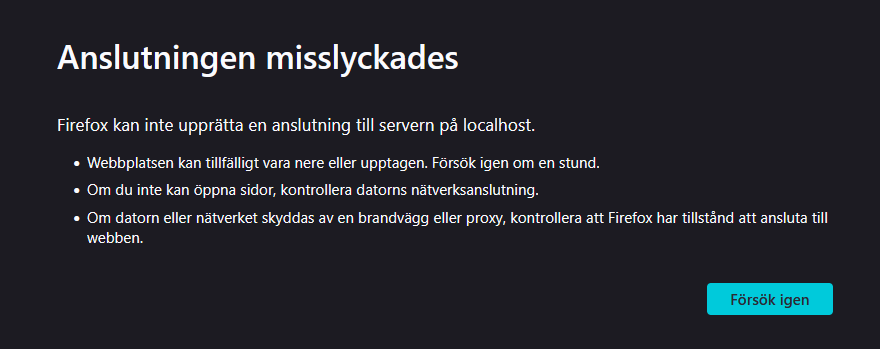
Cant add email to Thunderbird
I get to the point when a window to authenticate my log in appears. But it is blank. I copy the link and select all info to let thunderbird see but then Firefox fails to sustain connection to localhost and MS Edge also fails.
I don't know why. I disable firewall and still problem.
ఎంపిక చేసిన పరిష్కారం
I solved it.
The problem was that I installed it on Q: (Non windows partition) instead of in C: (Windows Drive). I was also trying to reinstal firefox on my Q drive but when I opened at new tab it just gave me failure. I have given up on having any Mozilla product on another drive
ఈ సందర్భంలో ఈ సమాధానం చదవండి 👍 0ప్రత్యుత్తరాలన్నీ (4)
You might want to try enabling cookies in Thunderbird. They are enabled by default, be there are always folk and software that think they need to be disabled. It sounds like that might be the failure point here as cookies pass the information from web page to web page in the flow.
Oath authentication certainly functions in a web page served by the respective account provider, but Thunderbird is the web client/ browser. Not Firefox, not Chrome and Not edge nor any other browser.
Cookies are enabled. The pop up is still blank and copying the link results in lost connection to local host. In Thunderbird it is just loading while saying controlling password.
I do not read the language, but I can read Firefox in there.

However if Firefox can not connect to localhost, what is blocking it? You can not complete the authentication using Firefox, but connection to your local machines host adapter (IP address 127.0.0.1) should still be possible.
I have seen folk with all sorts of software installed that causes these issues. But rather than try and explain it myself I will let the google AI do it. It is far more erudite than I am. I did vet what it said for errors. I didn't see any.
The inability to connect to localhost typically indicates an issue with a local server or application not running correctly or being blocked. Here are common reasons and troubleshooting steps: Server or Application Not Running: Verify that the local server (e.g., Apache, Node.js server, database server) or the application you are trying to access is actually running. If using a web server like Apache or Nginx, check its status and restart it if necessary. For applications, ensure the process is active and listening on the expected port. Incorrect Port or Configuration: Confirm that the application or server is configured to listen on the port you are trying to connect to (e.g., localhost:80, localhost:3000). Check for port conflicts, where another application might be using the same port. You may need to change the port for your server or application. Firewall or Antivirus Interference: Firewall or antivirus software can block connections to localhost. Temporarily disable your firewall or antivirus to test if it resolves the issue. If it does, add an exception for your server or application in your security software settings. Browser Issues: Clear your browser's cache and cookies, as cached data can sometimes interfere with connections. Try accessing localhost in an incognito or private browsing window to rule out browser extensions or settings. In some cases, specific browser settings related to domain security policies might need to be reset. DNS or Host File Issues: Ensure that localhost correctly resolves to 127.0.0.1. You can test this by trying to connect to 127.0.0.1 directly instead of localhost. Check your hosts file (located at C:\Windows\System32\drivers\etc\hosts on Windows or /etc/hosts on Linux/macOS) to ensure the localhost entry is correct. Application-Specific Problems: If you are developing an application, there might be errors within the application code preventing it from starting or listening on the port. Check application logs for error messages. Ensure all necessary dependencies for your application are installed and configured correctly.
Note that in this instance Thunderbird is the browser. I suggest you devote time to applications you have installed especially developer tools, web site products like Apache and antivirus and it's attendant firewall as they are the most common issues.
Have a look at this article. Nothing substantive has changed in the three years since it was written and the same sorts of issues still crop up. https://support.mozilla.org/en-US/kb/automatic-conversion-google-mail-accounts-oauth20
ఎంపిక చేసిన పరిష్కారం
I solved it.
The problem was that I installed it on Q: (Non windows partition) instead of in C: (Windows Drive). I was also trying to reinstal firefox on my Q drive but when I opened at new tab it just gave me failure. I have given up on having any Mozilla product on another drive


